East Jerusalem, West Bank 31 October 2006
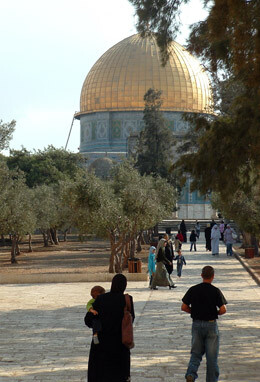
The Dome of the Rock situated in the Haram al-Sharif (Noble Sanctuary)
Central Tel Aviv along the beach seems like such a relaxed and cosmopolitan place. From here one can ignore the cataclysmic events taking place to the north in Lebanon, to the south in Gaza, to the east in the West Bank and even further to the east in Iraq. I feel tempted to just go swimming here in the Mediterranean Sea, let my feet nourish the sand, and just relax on this beach to work on my tan. It would be easy to remain oblivious here in Tel Aviv to all the turmoil surrounding us here, but I must move on.
My Israeli friend Nir gives me instructions on how to take the bus up the hill from Tel Aviv to Jerusalem. I board the bus, which is filled to capacity, and plop myself on the floor in the back, surrounded by young IOF soldiers. The trip takes less then an hour.
Then I take a taxi to Damascus Gate and find the local hangout for the International Solidarity Movement. I will stay here for two days, preparing and coordinating my travel to the northern West Bank, where I will be volunteering to work in a mobile health clinic sponsored by Palestine Medical Relief Society in villages near the towns of Qalqilya and Tulkarem. I buy a local mobile phone, which due to the numerous checkpoints, is an essential survival tool when traveling in the occupied Palestinian territories.
I meet Charlie Wilson, an ISM activist from California. Charlie has been here before, and was arrested, beaten and deported by the Israeli authorities for protesting in Bil’in during his last trip. Through various means that I will not divulge, he has infiltrated back into the country and is ready for more. We become fast friends. We walk the narrow passage ways of the old city Jerusalem, through Damascus Gate, along the Via Dolorosa and the 14 Stations of the Cross to the Church of the Holy Sepulcher, the site of Jesus’ crucifixion. We exit the Old City at Jaffa Gate and cross the Green Line, the former border prior to 1967.
We spend time on Ben Yehuda Street, the main pedestrian thoroughfare in Israeli West Jerusalem, and have a beer at a refusnik hangout. Then we wander back across the Green Line and through the Armenian and Jewish Quarters, descending before the vista of the Wailing Wall, and the Dome of the Rock. We pass through a security checkpoint to the Wailing Wall, and don paper Yarmulkes to pay our respects and touch the wall.
We see a sign for tourists that proclaims that Solomon’s Temple will be rebuilt for the third time. This is a scary thought, for it would necessitate the destruction of the Dome of the Rock, the third holiest shrine of Islam.
We head back to the ISM hideaway, getting lost a few times within the labyrinthine walkways of the Old City. It is now time to collapse until tomorrow morning …
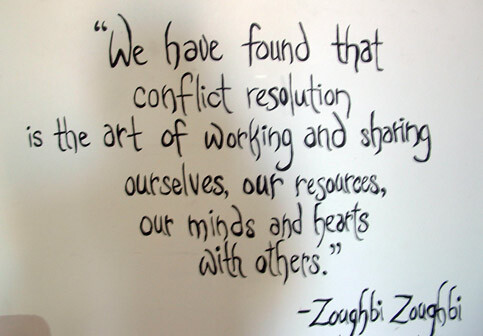
Zoughbi Zoughbi’s philosophy
25 October 2006
Today we take a group taxi across the Wall to Bethlehem in the south. We meet with Zoughbi Zoughbi and his American wife Elaine. Mr. Zoughbi is director of Wi’am, a local empowerment program in Bethlehem which uses techniques popularized by folks like Mahatma Gandhi and Martin Luther King — techniques of nonviolent active resistance, which help local people survive the pressures of occupation. Mr. Zoughbi is also a member of the Bethlehem city council.
Next, we head to Manger Square and meet Georges, who gives us a tour of the Church of the Nativity. We see the site believed to be the exact location of Jesus’ birth. Georges was stuck for over 40 days with 278 others inside the church during the siege in April 2002. He and his colleagues were surrounded by Israeli Occupation Forces, who tried to starve them into submission. Several were shot dead or wounded by Israeli snipers when they showed themselves at windows, or tried to smuggle food with outside assistance into the church. George gives us an audio interview describing what it was like to be inside during the siege.
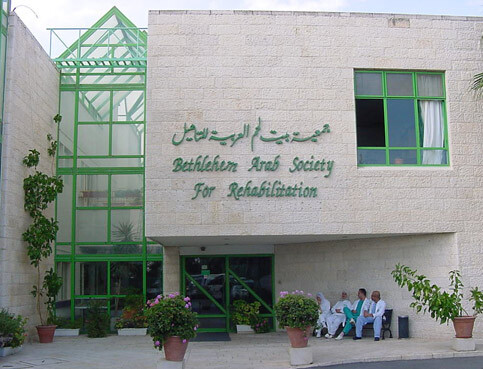
The Bethlehem Arab Society for Rehabilitation administered by Dr. Edmun Shehadeh
Now it is time for a reunion. After 21 years, I finally make it back to visit Dr. Edmun Shehadeh, who is a physiatrist, and runs the Bethlehem Arab Society for Rehabilitation. Dr. Shehadeh was my first contact when I came to Palestine for the first time as a medical student back in 1985. Though so many things in occupied Palestine have gotten so much worse because of the oppression, this is one facility that has gotten so much better.
Dr. Shehadeh’s rehab hospital is now a multidisciplinary facility. It is complete with orthopedic and general surgery services, hearing and eye care, occupational and physical therapy, vocational rehabilitation services, inpatient wards, and many other services. Like so many social services in Palestine, it relies on contributions from international non-governmental organizations, or NGOs, to survive.
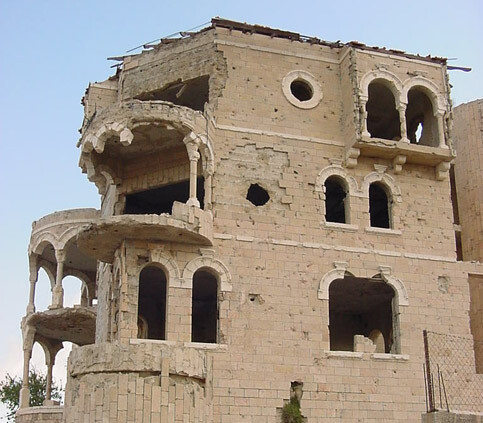
Homes in Beit Jala which were ravaged by Israeli artillery fire from Gilo in spring 2002
This rehabilitation hospital is located in Beit Jala, right next to Bethlehem. A large deep valley lies immediately to the north, and the settlement of Gilo, built over 20 years ago on confiscated East Jerusalem land, can be seen on top of the hill on the opposite side. There is also a settler-only highway that is off limits to Palestinians. The annexation wall is being constructed right below the window of Dr. Edmun Shehadeh’s office.
Now it is getting late. We head back in the dark across the horrific new terminal that has been constructed by Israel in the past year. It has a concentration camp feel to it. We head back to East Jerusalem.
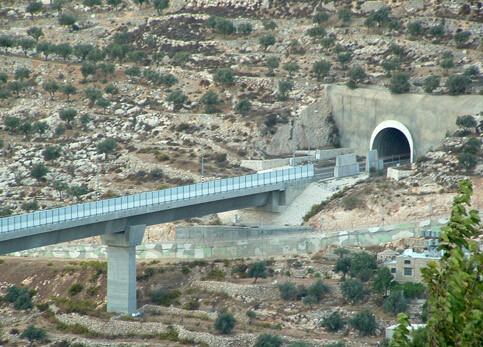
View of the highway from the Gush Etzion settlement block of towards Jerusalem, which only cars with Israeli plates are allowed to use, as seen from the window of Dr. Edmun Shehadehs office
26 October 2006
Today is a day mainly for writing and preparation. In the afternoon we meet with Mr. Mordechai Vanunu at the American Colony Hotel in East Jerusalem. I met Mordechai the first time a year and a half ago.
It is now two years since he was released from Ashkelon Prison, after an 18 year sentence for telling the world of Israel’s nuclear arsenal. A former worker involved in the production of plutonium at Israel’s Dimona reactor in the Negev desert, Mordechai revealed that Israel possessed over 200 fissile warheads and 200 hydrogen bombs in 1986. For that he was kidnapped in Rome, and sent to prison, spending 11 years in solitary confinement. By now, the numbers of nuclear weapons possessed by Israel may be much higher. In spite of all the hardship, Mr. Vanunu does not regret this; he says he did a very good thing.
With all the hype about Iran’s nuclear program currently in the Western media, there is virtual silence about Israel’s well-established weapons program.
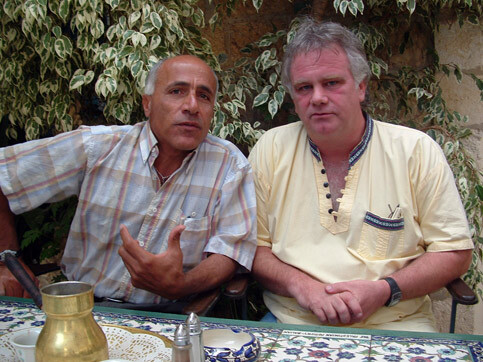
The author with Mordechai Vanunu at the American Colony Hotel in East Jerusalem
I ask Mordechai more about nuclear proliferation issues in North Korea and in Iran. He believes there is no stopping additional countries from getting the atom bomb as long as the hypocrisy and double standards continue. Developed countries like Israel and the US continue to violate the Non-Proliferation Treaty by refusing to disarm. Not only that, they continue to develop weapons like neutron bombs and smaller tactical nukes. And they continue to use depleted uranium and chemical weapons like white phosphorus in places like Lebanon and in Iraq.
Mr. Vanunu believes that it is only a matter of time before Iran gets the bomb, whether Israel or the United States bombs Iran or not. The more we threaten Iran, the more they feel they need atomic weapons to defend themselves from us — the more we jeopardize peace and stability in the world. If we really want to stop Iran and other countries from developing nuclear weapons, the US and Israel must open their facilities to inspection and start dismantling their arsenals as part of being respectful members of the greater world community of nations.
I ask Mordechai about how peace and stability can be achieved between Israelis and Palestinians. He replies simply: through equal rights and justice. Palestinians must have all of the rights given to Jews in this land. The Apartheid laws, which favor Jews over all others, must end.
We say goodbye to Mordechai, and I give him a hug. I repeat what I said to him last time: “I hope to see you someday soon in Seattle.” “That would be great,” he remarks, “if only I could get out of this place.” This is for the Israeli legal system to decide. He is still prohibited from getting anywhere close to the border or traveling abroad.
Charlie and I take a bus across the Wall toward Ramallah and other parts of the northern West Bank. Now we will not make it back to Jerusalem for a while.
Dr. Bill Dienst is a rural family and emergency room physician from Omak, Washington, USA.





